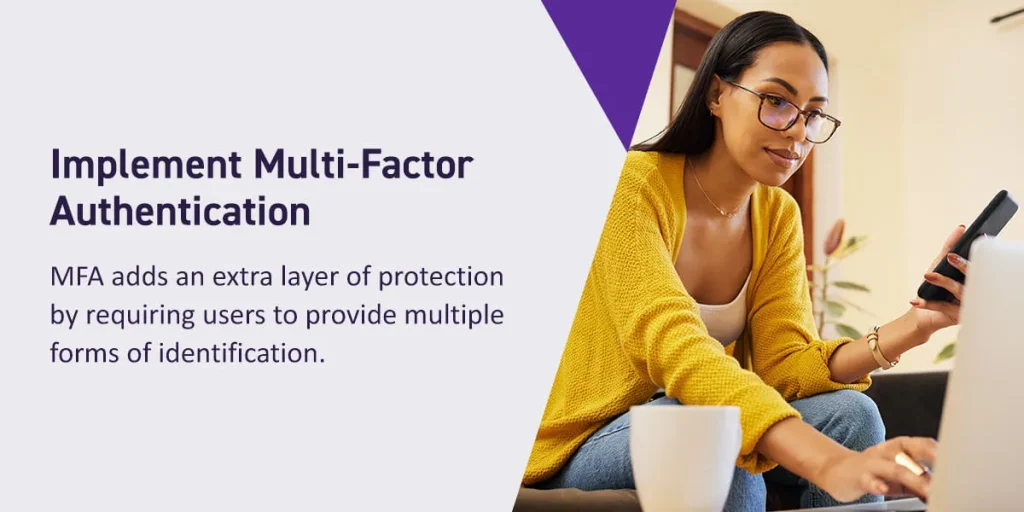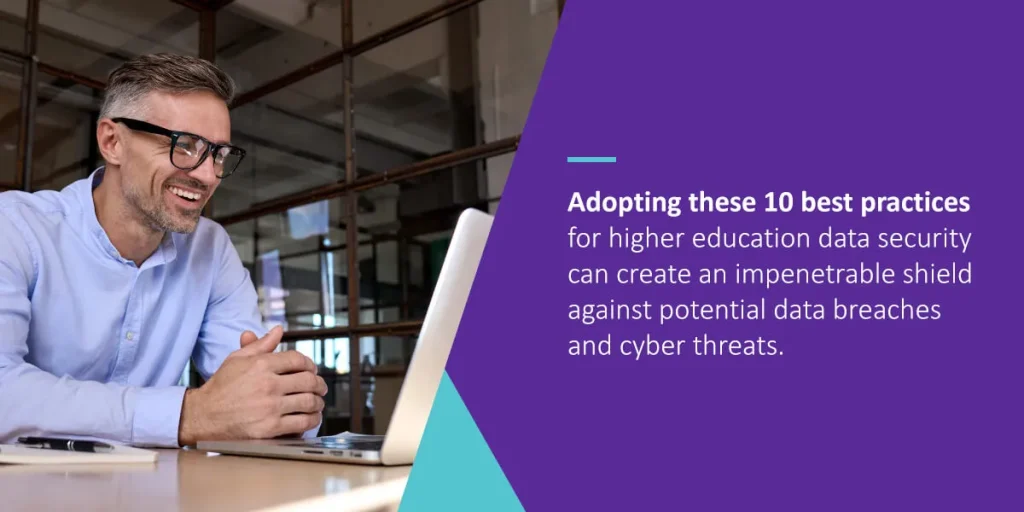




In today’s digital era, data security has never been more crucial. Statista forecasts that the worldwide market for data security will reach $10.78 billion by 2028, reflecting a significant increase from $5.98 billion in 2023. However, only 13% of the world had their data protected in 2023. Now is a crucial time to implement data security best practices in all industries.
And that includes the higher education industry. If you work with student and institute data, it’s more important than ever to have clear policies and processes for data security, to implement them effectively across all responsible parties, and to update them frequently. Every institution has its own procedures, but here are 10 best practices for higher education data security.
It can be challenging to interpret the data protection regulations outlined by federal and state laws and ensure that they align with the processes you already have in place. Ensure that you or someone on your team is responsible for thoroughly understanding these regulations, keeping current with any new laws, and disseminating this information to anyone who needs to be aware of it.
Keep an inventory of data and track its usage. This could include intellectual property, student information, and employee data. You can develop a comprehensive and proactive plan to protect each data category by identifying the kind of data you’re working with. This is where data management strategies come into play.
Examine your institution’s policies, train your staff on procedures and best practices, and discuss different scenarios that may arise. Make sure staff know the proper guidelines for releasing information, verifying identity, best security practices, and who to contact with any questions or problems.
Third-party vendors are your institution’s partners in effectively using data to inform improvements on campus. Your partner should be a company you can trust, with a proven track record of successfully delivering solutions and a dedicated and knowledgeable support team. Selecting the right partner means you don’t need to worry about whether the data they can access is at risk.
Driving institutional improvements and assessing your university’s progress towards these goals is a significant team effort involving students, faculty, university leadership, and legislators. It is crucial to provide clear information about what data your institution uses, how it uses it, and, most importantly, why. If stakeholders understand the value of your work and how it advances your institution’s mission, they will be more likely to take an active role in supporting your data security policies.
One effective measure to safeguard sensitive information is implementing multi-factor authentication (MFA) across institutional systems and accounts. MFA adds an extra layer of protection by requiring users to provide multiple forms of identification, such as a password, a unique code, or a biometric scan.
This approach significantly reduces the risk of unauthorized access, even if someone compromises the login credentials. By embracing MFA, higher education institutions demonstrate their commitment to the importance of data security and employ one of the best practices for higher education data security.

When it comes to data security in higher education, one best practice reigns supreme — regularly updating and patching systems. Keeping software, applications, and systems up to date with the latest security patches is paramount.
Timely updates act as a shield against known vulnerabilities, reducing the risk of unauthorized access, and fortifying higher education data security. By staying current with updates, institutions can stay one step ahead and strengthen their defense against potential cyber threats — ensuring the integrity and confidentiality of their valuable data. Stay proactive, update those systems, and safeguard your institution’s digital assets.
To strengthen higher education data security, encrypting sensitive data is paramount. Encryption provides a vital layer of protection for data both at rest and in transit. Encryption ensures that even if someone compromises physical or network security, gaining unauthorized access to sensitive data remains challenging by converting information into an unreadable format.
This safeguarding measure prevents potential data breaches from exposing confidential information. Encryption technologies, such as robust algorithms and encryption keys, are crucial in preserving the confidentiality and integrity of valuable data assets within higher education institutions. By implementing encryption, administrators can have peace of mind, knowing they are shielding their sensitive data from unauthorized access.
As higher education institutions navigate the complex data security landscape, conducting regular security assessments emerges as a vital best practice. These assessments, including penetration testing, play a crucial role in identifying vulnerabilities and evaluating the effectiveness of existing security controls. Engaging external security experts offers an unbiased evaluation of an institution’s security posture.
By embracing regular assessments, higher education institutions can proactively address weaknesses, fortify their defenses, and enhance their overall data security measures. Through these assessments, institutions gain valuable insights, allowing them to stay ahead of evolving threats and ensure the protection of sensitive data entrusted to their care.
In the ever-changing landscape of data security in higher education, having a well-defined incident response plan is crucial. Such a plan ensures preparedness and enables effective handling of security incidents. An incident response plan should outline critical components, including clearly defined roles and responsibilities, designated communication channels, containment measures, and a step-by-step process for investigation and recovery.
By establishing an incident response plan, higher education institution administrators demonstrate their commitment to data security and readiness to address any potential breaches. This proactive approach instills confidence in stakeholders, assuring them that their institution has the necessary equipment to respond swiftly, minimize the impact of incidents, and protect sensitive data.

Adopting these 10 best practices for higher education data security can create an impenetrable shield against potential data breaches and cyber threats. They are crucial to protecting sensitive information and maintaining the trust of students, staff, and stakeholders. Staying informed, assessing third-party vendors, implementing MFA, and conducting regular security assessments — these are the best practices we recommend combining for higher education data security that creates a comprehensive solution.
However, it doesn’t end there. Ongoing vigilance, adaptability, and collaboration are vital to staying ahead of evolving security threats. As a bonus best practice, we recommend streamlining data integrations. By consolidating and centralizing data systems, you simplify the data landscape, reducing potential vulnerabilities and unauthorized access points.
By embracing these best practices and continuously refining your approach, you can confidently navigate the complex terrain of data security in higher education, ensuring the privacy and integrity of your institution’s valuable data assets.
Interested in learning more about data security? The U.S. Department of Education, the National Association for College Admission Counseling (NACAC), and EDUCAUSE have insightful resources on student privacy and data security.





























































































































































































































































































































































































